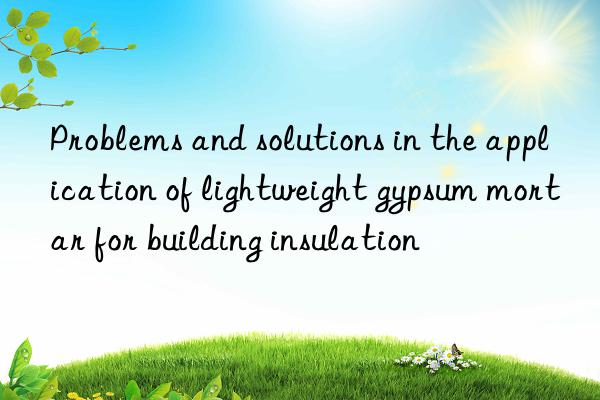
In practical applications, the main problems of thermal insulation mortar are insufficient strength, poor thermal insulation effect, and high water absorption of vitrified microspheres.
1. Poor thermal insulation effect
In the current market, the density of vitrified microbeads At 80~120kg/m3, during the construction and production process of mortar, some parts will be broken due to external mechanical force, and the density will also increase. In this case, the thickness of the insulation layer during construction cannot be well guaranteed, and the thermal conductivity coefficient will further increase due to the fragmentation of the vitrified beads. In fact, the energy-saving effect that can be achieved is comparable to the design requirements. Compared to, very different.
2. Low strength
The pressure-shear bonding strength and compressive strength of insulation mortar can be directly related to Regarding the adhesion safety of thermal insulation, many products increase their strength performance at the expense of dry density and thermal conductivity. However, due to its low strength products, many quality accidents have occurred. For example, tens of thousands of square meters of a residential area in Hefei City are insulated. Since the strength of the insulation layer is not high, when the bonding surface needs to be cut for tensile strength testing on site, the crack-resistant protective layer will be cut during cutting. Automatically falls off.
3. High water absorption
The high water absorption of the insulation layer mentioned here is not the previous one. The so-called high water absorption rate of the thermal insulation mortar itself is a problem caused by the product quality of the thermal insulation mortar. In the process of producing thermal insulation mortar, some individual manufacturers have higher costs due to cost or the purchase of vitrified microbeads. They use vitrified microbeads together with a large amount of ordinary expanded perlite, causing water absorption. rate becomes higher.
Application suggestions for building thermal insulation lightweight gypsum mortar wall insulation system
1. Correct understanding of thermal insulation Applicability of mortar
Thermal conductivity of thermal insulation mortar is very high, which shows that its thermal insulation properties are limited. Therefore, it will also be used in places with hot summer and cold winter. There are certain restrictions. In fact, it is more suitable for external wall insulation or internal wall insulation in areas with hot summers and warm winters. Especially for exterior walls that require pasted tiles or decorative stones or curtain walls that are required by design, using thermal insulation mortar for insulation is a good choice.
2. Strengthen the anti-crack protective layer
Thermal insulation of lightweight gypsum mortar exterior walls Research on system technology and application As far as the current usage is concerned, most of them are equipped with anti-cracking protective layers. The characteristics of vitrified microbeads are different from those of polystyrene particles. Its density itself is very high. Moreover, when configuring thermal insulation mortar, it is usually necessary to add some air-entraining agents to meet the requirements. The result of this is usually that the cost of raw materials is too high and the strength is low. Assuming that a crack-resistant protective layer is installed in this case, the advantages of the external insulation system in terms of self-weight, cost, construction cost and construction period are no longer obvious, and the effect is not even as good as that of rubber powder and polystyrene particles. Insulation slurry. On the contrary, assuming that the anti-cracking protective layer is eliminated, the material cost saved in this regard will be used to increase the content of organic components in the mortar. Then, there will be obvious advantages in all aspects mentioned above.
3. Strengthen the research on the application technology of new thermal insulation mortar
Under the current situation, the research on new thermal insulation mortar There is not much research on applied technology, and strengthening research in this area will be more conducive to application. For example, vitrified microspheres and polystyrene particles are combined to form a composite thermal insulation slurry. Polystyrene particles are introduced to solve the problems caused by insufficient dry density, strength and thermal conductivity while ensuring that the mortar maintains thermal insulation performance. The combination of treated expanded perlite and vitrified microbeads will also produce good results.
4. Use functional coatings as the finishing layer of thermal insulation mortar exterior wall insulation
Insulation lightweight gypsum mortar and reflective insulation coating are combined to form a high-performance exterior wall insulation system. It will be an excellent exterior insulation system in areas with hot summers and warm winters. Because after this kind of coating is applied to the external insulation surface of the exterior wall, the surface temperature of the coating film will not increase significantly, and it can significantly reduce the heat transfer through the wall to the building. After coating with reflective heat-insulating coating, the temperature of the coating surface can be lowered by 15 to 18°C than when no coating is applied or when ordinary coating is applied. This will be an excellent way to solve problems such as cracking and accelerated aging of coating films caused by high surface temperatures of exterior wall insulation and possible large temperature differences. </p



 微信扫一扫打赏
微信扫一扫打赏
